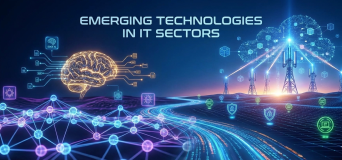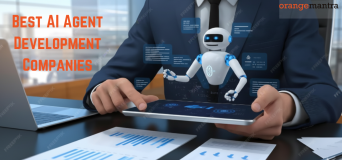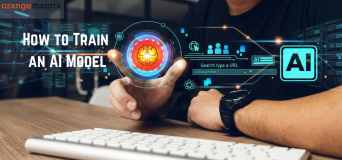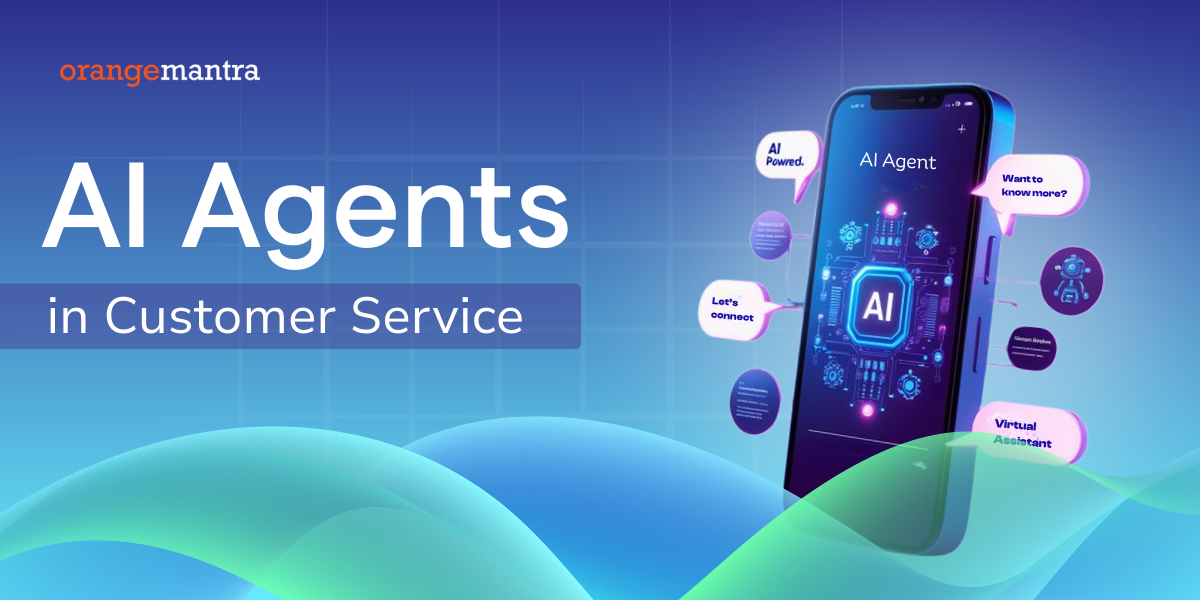
By the end of this guide, you’ll understand how AI agents can transform customer service. You’ll learn how to identify pain points, set measurable goals, choose the right AI platform, and run a pilot program. Plus, you’ll discover how to train, integrate, and scale AI agents for long-term success.
Do you know?
- Nearly 9 out of 10 businesses are actively investing in some form of AI, with customer service being a major area of focus.
- AI-enabled agents can handle nearly 14% more customer inquiries per hour and reduce overall operational costs by up to a surprising 30%.
- Companies using AI report an average 37% drop in first response times and resolve tickets over 50% faster.
- AI chatbots can handle up to 80% of routine tasks and inquiries, freeing human agents to focus on complex cases.
There are so many possibilities and opportunities with AI, more or more specifically AI agents in customer services. It is taking the domain by storm. So much so that social media is hyped with the possibilities of AI in customer services.
However, you know what is the saddest part?
Nobody tells you exactly how to do it. But not anymore because we will.
We have prepared this detailed guide just for decision makers like you who have no idea what’s going on and what’s going to happen.
No sweat! This guide will give you a clear idea on how to bring AI into your customer service function. In fact, why limit to just bringing it, this guide will also help you even scale throughout your customer services.
It will help them understand AI capabilities, the future possibilities with it and more importantly, how to get started. Moreover, if you successfully implement the step charted out below, it will become easier for you to replicate success in other functions, say marketing and sales for example.
So, my suggestion for you would be to save this guide and keep coming back for reference. And without delay, let’s…get …. STARTED!!!
Table of Contents
Step 1: Identify Pain-point to be Solved by AI agents in Customer Services
Implementing an AI agent is a strategic decision, not just a technological one.
It’s about vague feeling of “our customer service could be better” or “Let AI agents do it all” to a data-driven diagnosis of specific, addressable problems, and gaining tangible value right from day one.
Rushing through this step means you’ll likely end up with an ineffective outcome. Or worse, something that requires costly revisions.
What to expect from this step?
This step ensures that you AI agent strategy is:
Goal-Oriented: It’s built to solve real business problems, not just to have “AI.”
ROI-Positive: You can directly measure its success against pre-defined pain points.
Seamlessly Integrated: You’ll understand exactly where it needs to plug into your existing workflows.
How to identify the bottleneck?
To identify bottlenecks in your customer services, you need to look into the following four key areas:
- Speed – Analyse Response and Resolution Times
- Efficiency – Scrutinize Operational Costs
- Quality – Evaluate Interaction Consistency and Quality
- Experience – Map the Customer Journey and Channel Friction
For this, you could get help from your customer service leads, support agents, and data analysts for this activity.
Use the following template (with example entries) to record your findings:
| Bottlenecks | Specific Pain Point | Data Source & Evidence | Impact |
| Response Time | High first response time during peak hours (10am-2pm) | Helpdesk Report: Avg. 4hr wait time | 15% increase in complaints |
| Operational Cost | High volume of simple password reset tickets | Ticket Data: 500 tickets/month | ~50 hours of agent time wasted |
| Consistency | Inconsistent returns policy explanations | QA Sample: 40% inaccuracy rate | Low CSAT on policy-related tickets |
By the end of this step, you should be in a position to complete this sentence:
“We need an AI agent specifically to solve [this problem], in order to achieve [this outcome].”
Looking to Enhance Your Customer Service with AI?
Discover how AI agents can automate support, improve response times, and boost customer satisfaction for your business.
Step 2: Setting Clear Objectives and Quantifiable KPIs
Finishing the first step, you have the pain-point to deploy an agent. Now you need to come up with a solution and see if it is working or not.
For this, you need to set a clear objective with quantifiable KPIs. For example, reducing waiting time by 30%.
Without such an objective, it will be difficult to understand the performance, more importantly, prove its value to stakeholders, secure expansion budget, or know what to optimize.
Through these success metrics, we can build a business case for AI and ensure a tangible ROI. These metrics will be in on three levels:
Level 1 KPIs: Assess Agent’s Direct Performance – Is it Working or Not?
As you can figure out, these metrics are to evaluate the performance and accuracy of the AI agent itself. This can be on three fronts:
- Automation Rate: How much percentage of customer interactions are being fully handled by the AI – no human intervention. This is the primary measure of deflection and efficiency, and a high rate will your human team is being freed up.
How to measure:
(Number of conversations fully resolved by AI / Total number of conversations) * 100
- Escalation Rate: Further, you also need to see the percentage of cases where the AI transferred the case to a human agent. If this is high, this could mean that your agent is struggling. It might need better training or might be deployed for another types of queries.
How to measure:
(Number of conversations escalated to human / Total number of conversations handled by AI) * 100
- AI Accuracy / Intent Recognition Rate: Is your agent capable of understanding customer concerns properly, providing correct responses and for how much percentage of times? If this metrics is low, it will lead to frustration for the customer and more escalations for you.
How to measure:
This often requires manual sampling and grading of a subset of conversations (e.g., on a scale of 1-5 for response relevance).
Level 2: Operational Metrics – Is it helping?
These are classic KPIs that measure the performance of the entire customer support function. If you have created a good agent, it should contribute to the improvement of these KPIs. These are
- Average First Response Time (AFRT): By responding in milliseconds, AI agent should drastically reduce this metric and improve the customer’s immediate experience.
- First Contact Resolution (FCR) Rate: By their very nature, agents excel at instantly resolving common, simple issues, thereby boosting FCR rate.
How to measure:
(Number of tickets resolved on first interaction / Total number of tickets) * 100
- Average Handling Time (AHT): While AI’s own handling time is near-zero, the true impact will be visible on the Customer Support Executives. The human team will provide agents with context, summaries, and suggested next steps to get the resolution in no time.
Level 3: Business Impact Metrics – Is it worth it?
These metrics are to check if AI agents are capable enough to impact your business. This helps connect the AI agent’s work to overarching business goals.
- Customer Satisfaction (CSAT) Score: The classic KPI is the ultimate barometer whether the AI agent is providing a good experience. We would suggest you segment scores by AI-handled vs. human-handled conversations.
- Net Promoter Score (NPS): Improving NPS indicates your AI strategy is strengthening your brand.
- Cost Per Resolution: AI should significantly lower this number by deflecting tickets and increasing agent efficiency.
- Agent Productivity: As AI handles the simple stuff, humans’ productivity should increase and, often, their job satisfaction.
Check the following infographic to better understand.
Your vague goal is now concrete and measurable; you have a plan to implement and a scorecard to evaluate your AI agent’s performance.
This brings us to Step 3, where you will make the next critical decision of choosing the AI platform that will get you there.

Step 3: Choose the Right AI Agent Platform
Till now our groundwork is done, foundation is all set, now we need to select the right engine to power our AI agent.
Mind! Make no mistake of choosing the most popular or hyped one. There is a sea of AI agent platforms but only a few will fit your specific requirement that we identified in the above 2 steps.
Use your knowledge gained in the above step to filter the best ones otherwise you will be left nothing but overwhelmed. In this step, we will be sharing the knowledge and data that you need to identify the best AI agent for your goals.
Mind you that this part can be a little tricker. It would be better if you reached out to an AI agent development company for consultancy and solutions.
What is an Enterprise-grade AI Agent Platform?
An enterprise-grade AI agent platform is a sophisticated AI system intelligence enough to understand user’s intent, make decisions, executing processes, and collaborate with human team and associated software with ease.
How to Identify the Best AI Agent in Customer Services
You need to evaluate AI agents against the following non-negotiable capabilities:
1. Advanced Natural Language Processing (NLP) and Understanding (NLU)
These capabilities determine how well the agent understands your customers. It takes into account:
- Intent Recognition:Accurate discernment of what a customer reallywants, including slang, typos, or vague language. The agent should “My thingy won’t log in” should be recognized as a “password reset” intent).
- Context Management:The AI agent should maintain the context of a conversation throughout a long interaction and across different topics. Nothing can be more annoying to a customer than to repeat their order number.
As per HubSpot, 62% of customers would rather perform an unpleasant task, like “handing out parking tickets,” than be stuck in a confusing phone tree or have to repeat themselves to multiple support staff.
- Multilingual Support:Your AI agent should support all the languages your customers speak, that too at a high level of proficiency.
2. Agentic Process Automation
This capability lets your agent take actions over and above the capability of providing information like normal LLMs do. It covers:
- Integrations: The AI agent should be able to connect across your system and make it unified.
It can be in the form of pre-built connectors where your AI agentic services comes with out-of-the-box integrations with your core systems like CRM (Salesforce, HubSpot), helpdesk (Zendesk, Freshdesk), live chat, and ERP.
Or it can be in the form of flexible APIs or a developer toolkit to build custom integrations. So, when a customer asked, “Where’s my order?” The agent could check your backend systems to perform actions like checking an order status, processing a return, scheduling an appointment, or resetting a password autonomously.
In short, it should be able to integrate with components across your systems to create a unified view. This will help both customers and your human team by providing a complete picture of the issue being resolved.
- Workflow Automation: Handing customers is a multi-step process, you selected AI agent should be capable of handling that. Be it guiding a user through a troubleshooting flow, or to automatically create a ticket in your helpdesk with the entire conversation history, if the troubleshooting fails.
- AI-Driven Decision Making: Finally, the agent should come with embedded reasoning so that it can choose the next best action and knows when to call for human intervention.
3. Sentiment and Emotion Analysis
Understanding the context is not enough, the agent should understand customer’s feeling as well so that it can come up with appropriate responses and handle the case with required sensitivity. Check the following aspect:
- Can the platform detect frustration, urgency, or satisfaction from the customer’s language?
- Does it have protocols for handling negative sentiment?
4. Scalability, Security, and Governance
These capabilities separate enterprise-ready solutions from normal tools.
Scalability: Check how many queries the AI agent can handle and, more importantly, if the number meets your needs. AI agent built on cloud infrastructure can easily scale.
Security & Compliance: This is a very critical and complex one, you need to ensure that your selected AI agents is compliant with all the relevant compliance standards.
This can be Global and Regional Data Privacy like GDPR, CCPA/CPRA. Some Industry-specific regulations like HIPAA (Healthcare), PCI DSS (Payment Handling), KYC/AML. Lastly, Information Security and AI Governance such as ISO/IEC 27001 & 27018, SOC 2 Type II, and the recent one – EU AI Act (March 2024).
Analytics & Governance: This one will decide the success and failure of your AI agent project. Your AI agent should provide detailed dashboards on the metrics you defined in Step 2. Moreover, it should be able to learn and improve overtime through live data. And lastly, it should have adequate admin controls to adhere to compliance and prevent misuse.
Here is the top platforms for AI agent in customer services and their comparison:
| Platform | No-Code Builder | Key Features | Free Plan | Pricing Range | Best For | Limitations/Cons | G2 Rating |
| Kommunicate | Yes | Multi-channel, LLM-powered, deep integrations | No | $40–$200+/mo | Most industries | Lite/entry plan limited | N/A |
| Tidio | Yes | Multichannel, Lyro AI chatbot, templates | Yes | $24+/monthly–Custom | Growing businesses, ecomm | Advanced features need upgrades | 4.7/5 |
| Intercom | Yes | Central inbox, AI chat/help desk | No | Free trial, then paid | Enterprises, support teams | No free plan | 4.5/5 |
| Zendesk | Yes | AI analytics, robust ticketing, multi-channel | No | $55–$169+/agent/mo | Enterprises, advanced analytics | Complex navigation/data sync | 4.3/5 |
| HubSpot | Yes | CRM-integrated AI, shared inbox | Yes | Free–$150+/mo | CRM-driven orgs | Complex setup | 4.4/5 |
| Gorgias | Yes | Ecommerce, intent/sentiment AI, integrations | No | $60–$210+/mo | Shopify/ecommerce | Limited reporting | 4.6/5 |
| Ada | Yes | Multichannel, drag & drop, API integrations | No | Custom pricing | User-friendly automation | Integration bugs | 4.6/5 |
| LiveChatAI | Yes | No code, secure, contact management | Yes | $20+/mo – Custom Pricing | Enterprises, secure/scalable AI | Enterprise pricing mostly custom | N/A |
| Google Vertex | Yes (tech-heavy) | Multi-agent, integrates Google Cloud | No | Custom pricing | Large technical teams | Setup/price complexity | N/A |
| IBM WatsonX | Yes | Orchestrate, enterprise features | No | Custom pricing | Enterprises/industrial | Pricing complexity | N/A |
| Microsoft Copilot | Yes | Azure integrations, cross-platform | No | Custom pricing | Enterprises/MS ecosystem | Data diligence/time setup |
Key Insights
- Platforms like Kommunicate, Tidio, and Intercom are favored for rapid deployment, strong integrations, and simplified automation.
- Zendesk, HubSpot, and Gorgias provide advanced analytics and CRM integration, especially for larger teams and ecommerce.
- Enterprise/AI specialist platforms (e.g., Google Vertex, IBM WatsonX, Microsoft Copilot) excel with advanced controls, deployment options, and scalability, but require technical expertise.
- Most platforms provide a no-code builder, multi-channel support (web, social, email), and workflow automation, with varying analytics, reporting, and customization options.
- Pricing and limitations vary widely—free trials and entry plans are common, but advanced capabilities usually require paid upgrades or enterprise contracts.
For a midsize business looking for a balance of features, ease of use, and cost, Tidio, Intercom, and Gorgias rank highly. For large enterprises or technical teams, Google Vertex AI Agent Builder and IBM WatsonX stand out due to scalability and integration depth.
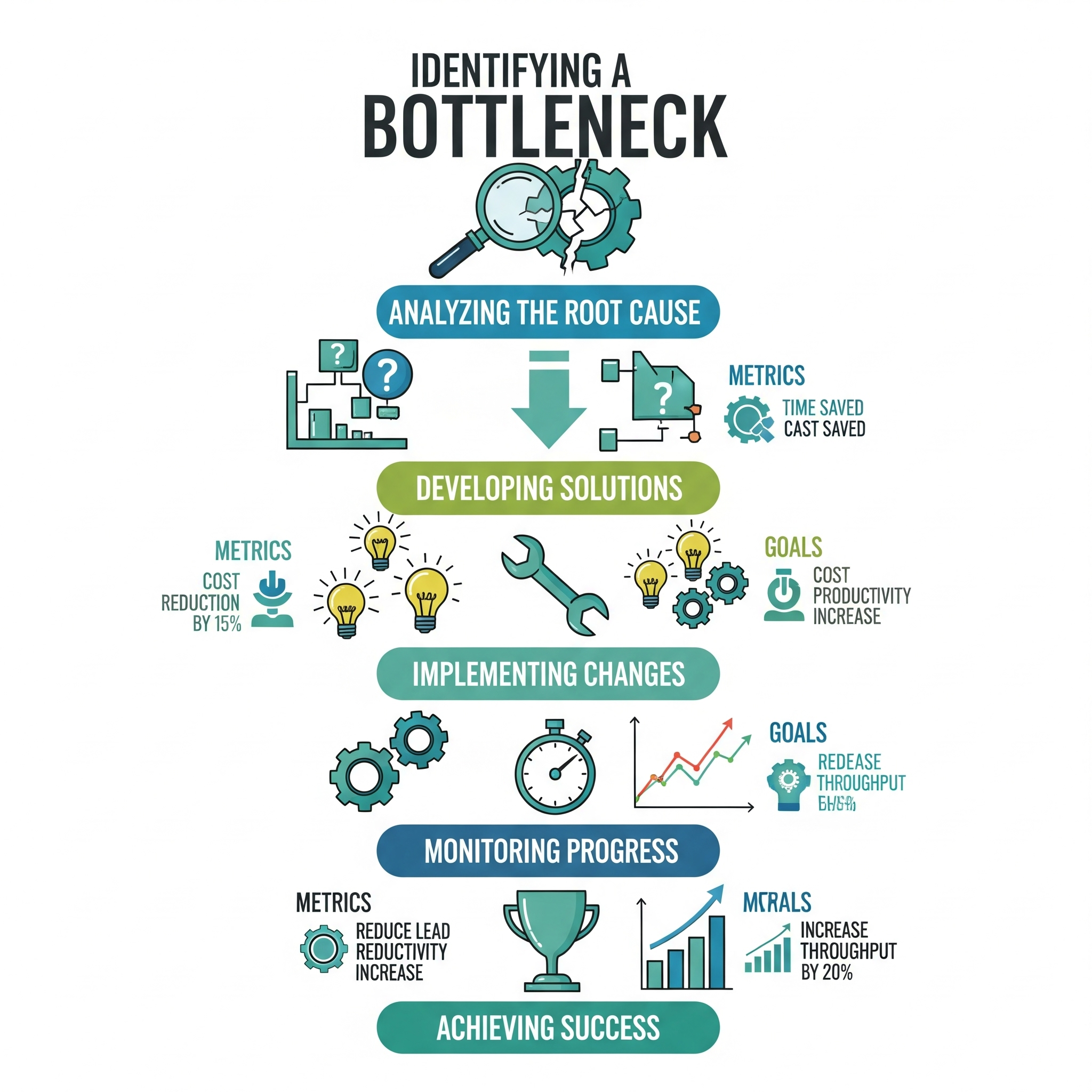
Or you can connect with an AI development services provider to reduce workload.
Step 4: Run a Pilot Program
By now, you might be either confident or overwhelmed. If you’re overwhelmed, then take a pause and read step 3 again. If you’re short on time, then get help from a conversational AI platform expert. They can help you choose the right one.
If you are confident, then read ahead. You are all set to enter the most critical phase of this project: bringing your AI agent in the real world with this pilot project. Here you need to keep few things in mind:
- This phase of pilot program is your controlled, low-risk experiment. A microcosm of your whole AI agent in Customer Services project. Ensure to make it well-defined in terms of process to follow and output to expect. At the end, you should get actionable results.
- The goal of the pilot project is not to achieve perfection on day one but to learn, measure, and refine. Validate assumptions, identify unforeseen edge cases, and, more importantly, build your confidence and that of your team and customers.
- Don’t go all out for all customer queries on all channels. Start small and focus on one channel first.
- The KPIs of your pilot project would be distinct from your main project.
Phase 1: Meticulous Pilot Planning
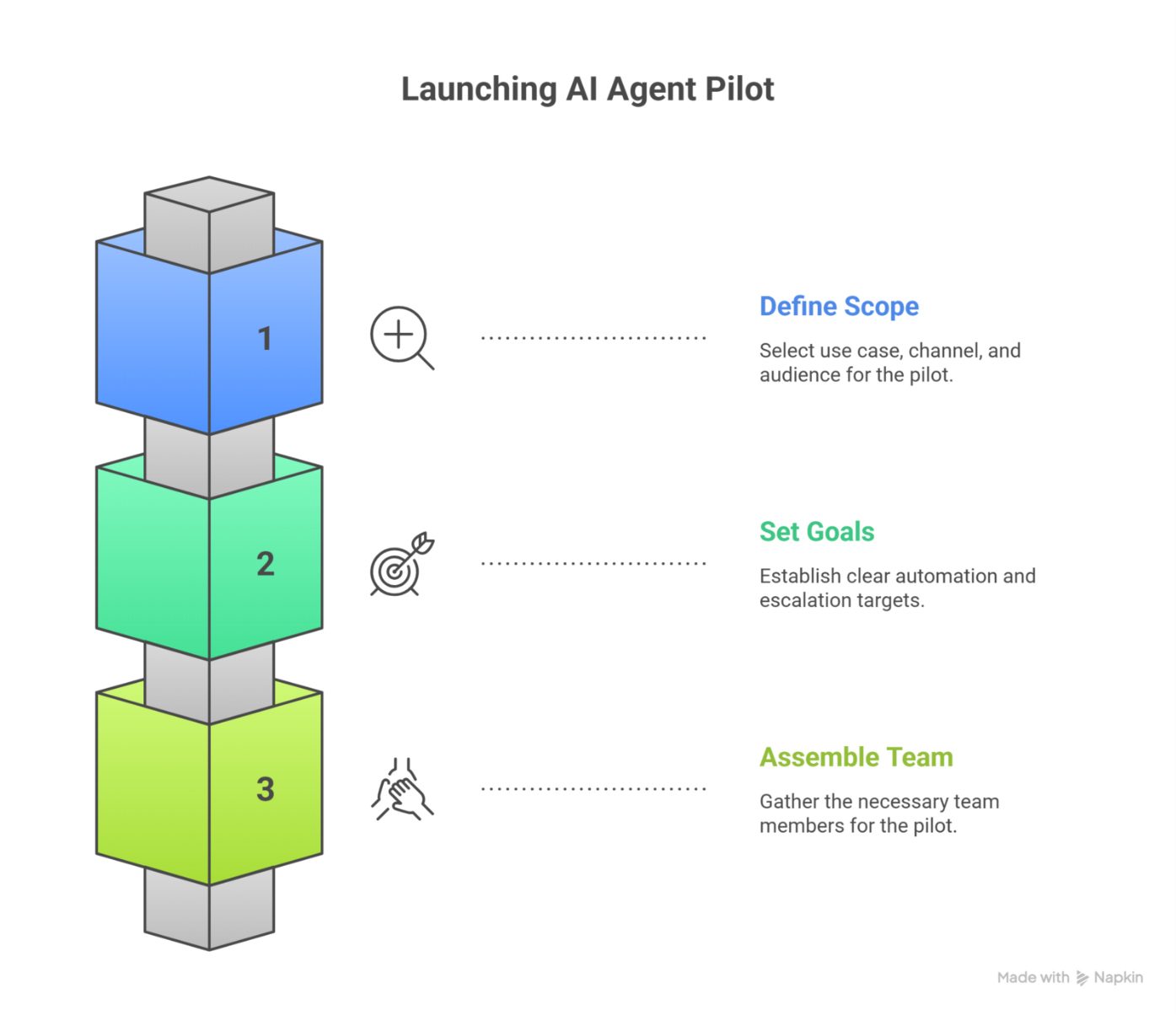
Define the Scope with Precision:
- Select a specific use case i.e. single, high-volume, low-complexity intent identified in Step 1
- Select a specific channel to launch your AI agent.
- Select a specific audience to releasing AI agent. (Optional but recommended)
Set Clear Pilot-Specific Goals:
Example Goals: >80% automation rate for the “password reset” intent, <15% escalation rate for the pilot use case, etc.
Assemble Your Pilot Team:
- Project Lead
- Customer Support Lead
- AI Agent Manager (internal or third party)
- Data Analyst
Phase 2: Execution & Active Monitoring
- Communicate Internally and train Your Support Team on every aspect of the project.
- Launch and monitor in real-time.
- Gather feedback systematically from customers and from support the human agents. Our suggestion – Create a Dedicated Channel on Slack.
Phase 3: Analysis, Refinement, and the Go/No-Go Decision
Analyse the Data by compiling all your quantitative and qualitative data into a pilot report.
- Quantitative: Did you hit your pilot goals?
- Qualitative: What were the common themes in customer and agent feedback?
Refine and iterate. Find these flaws beforea full launch.
- Review conversation logs to identify the most common escalation reasons or failure.
- Retrain the AI on new data, create new dialogue flows, and fine-tune intents to address the weaknesses uncovered.
- Test again for a few days before scaling to confirm your fixes.
Make the Go/No-Go Decision:
Present your findings to stakeholders, lead to one of three decisions:
- Go for broader rollout, if the AI agent is meeting its goals only minor issues to be resolved.
- Iterate, it the concept is valid, but significant refinements are needed. Extend the pilot phase for another testing and improvement.
- No-Go: The pilot revealed fundamental flaws (e.g., the technology can’t handle the use case, customer backlash is severe). Go back to Step 3 (platform selection) or Step 1 (reassessing needs).
If you have got a “Go”, then congratulations you are on the right path to AI-powered automation! Now you need to integrate and scale AI agents into your business. But before that you need to train your AI and here comes step 5.
Step 5: Train AI Agents with Relevant Data
With the completion of pilot project, you must be beaming with confidence. However, we are not done yet. In fact, now comes the most challenging part of your AI in the customer services project i.e. to make its production ready. And it starts with training the AI agent on the relevant data to make it accurate in its response and empathetic towards customers. This has a risk as well; a poorly trained agent or an agent trained on biased data might not only frustrate customers and erode trust but also eat away your reputation.
Performance = (Quality + Quantity) *Data
What data you might ask. Here is the answer:
- Historical data i.e. chat transcripts, emails etc.
- Knowledge base (FAQs, manuals),
- Key customer intents (goals) with sample phrases.
Next comes the question of how. Then there can be various methods to train your AI agent. You can choose any of the following options:
- Intent-based Training: Manually map how customers phrase questions (user utterances) to what they want (intents).
- RAG (Retrieval-Augmented Generation): Connect the AI to live knowledge bases so it can generate accurate, up-to-date answers on the fly.
- Feedback Loop: Use thumbs-down buttons and escalation logs to identify failures.
Treat data as a strategic asset. Implement continuous training cycle for continuous development (read evolution) of your AI agent. This is needed to make your AI agent intelligent and separate it from traditional bots.
Moving forward, the next step is to integrate it with your existing system in complete harmony.
Step 6: Ensure Seamless Integration
The goal of integration step is to create a unified, 360-degree view of the customer so that the AI agent can take meaningful action.
This also gets reflected on the customer side with reduced customer frustration, negligible information silos, and intelligent and efficient service experience.
Here are the 3 critical integrations you need to ensure:
- CRM Integration: To let your AI agent access customer history and personalize interactions.
- Helpdesk Integration: To create, update, and resolve tickets with full context.
- Knowledge Base & E-commerce Platforms: To pull live information and process requests.
There is one more type of integration which many overlook, but this is what decides the success or failure of any AI project.
The Human-AI Integration
If you want to ensure successful rollout of your AI agent, you need to ensure that this transition is invisible and frictionless, especially from the customer POV. This includes the handoffs when AI is handing over case to human. You need to ensure that it is smooth on true fronts.
First, at the time of customer interaction, it should be a warm transfer i.e. the AI should explicitly introduce the human agent by name and provide them with the full context.
Second, on the level of workspace integration, where interface for AI agents is not supposed to be a separate tab. Instead, embedded within the existing helpdesk dashboard.
And now we need to move to the final step – a cycle of perpetual improvement.
Step 7: Time to Scale You AI Agent Deployment
This is the dream of every organization. To launch a project and scale it successfully. Even better if it is an AI project, give the trends these days.
In the above step when you launched the AI agent, it was just the beginning. The real work is to ensure continuous improvement, not a “set-it-and-forget-it” approach.
In this case too, the goal is to institutionalize a process for measuring performance and agents learning to expand its capabilities for maximum impact (including on your bottom-line).
This process contains three parts: Monitoring, Optimization, and Scaling.
Pillar 1: Establishing a Centralized Monitoring Dashboard
Moving beyond occasional check-ins, you need to establish a centralized dashboard to track key success metrics defined in Step 2. You need to keep an eye on:
- Performance Metrics: This includes automation & escalation rates, First Contact Resolution (FCR), Average Handling Time (AHT), etc.
- Business Metrics: Such as customer satisfaction (CSAT & NPS), Cost Per Resolution (CPR) and Human productivity.
- Conversation Quality: Track sentiment analysis for customer frustration or satisfaction. Check root cause of escalation.
Pillar 2: Optimize – The Continuous Refinement Engine
This is about acting on those insights (found in Pillar 1 just above) and closing the feedback loop.
- Weekly Tuning Sessions: Dedicated time in a week for AI managers and support leads to review where they will check:
- Escalation caused by Failing AI conversations.
- Low-rated AI interactions.
- New query types or issues AI agents isn’t equipped to handle.
The Optimization Toolkit:
- Add new training phrases to existing intents.
- Build a new intent and dialogue flow for emerging new topics.
- Check for any step confuses users. Simplify the language or break it into smaller steps.
- Constantly, check if AI’s wrong answers are emanating from the source knowledge. Fix it.
Pillar 3: Scale – The Strategic Expansion
Plan for expansion. This is how to scale strategically:
- Horizontal Expansion (More Use Cases): Use the data from monitoring to identify the next most valuable use case to automate. The criteria are again the same high volume, low complexity query and follow the same pilot process.
- Vertical Expansion (More Complexity): Train AI agent to handle more complex queries within existing domain.
- Channel Expansion (More Touchpoints): Deploy your proven AI agent to new customer channels.
- Proactive Engagement: Make AI initiate conversations when it spots any issues like shipment delayed. It can approach by saying “Hi, I noticed your shipment is behind schedule. Would you like me to track it for you?”.
Before we conclude: The Monitor-Optimize-Scale cycle is iterative. Every time you scale to a new use case, you begin from the monitoring step, creating a virtuous improvement cycle for your AI investment to grow.
Conclusion
Your AI agent can be the core and evolving part of your customer service strategy. It has the power to significantly drive down costs, boost customer satisfaction, and free your human team to solve more complex problems and more importantly, build deep, empathetic relationships with customers.
With our detailed 7-step guide your AI adoption is complete while ensuring real business value. The journey of bringing AI agents in customer service started with a single, well-defined pain point. Then, it grew into an intelligent, integrated, and indispensable part of your customer experience.
Thank you for staying till the end.
FAQs
Q1. How is AI used in customer service?
AI can be used in 3 ways: Handle queries (simple ones first then complex ones), assist human agents in handling complex and sensitive cases, automate operations as we have covered here.
Q2. Will AI agents replace customer service?
No, it’s not. As far as customers are human, AI agents will not replace customer services or for that matter any other function in the business. The only thing AI agent will do is to make customer services more effective, fast and customer oriented. It will help human agents understand the context and give resolution faster, but the human connection will be offered by human agents only.
Q3. Which AI is best for customer service?
There are many like Kommunicate, Intercom, Zendesk, HubSpot and many others. Read the detailed comparison in the above section.


